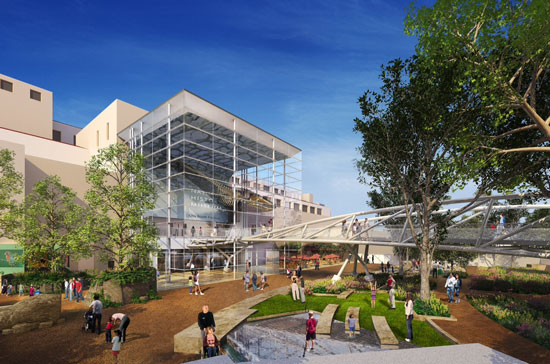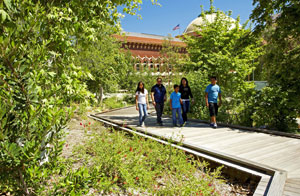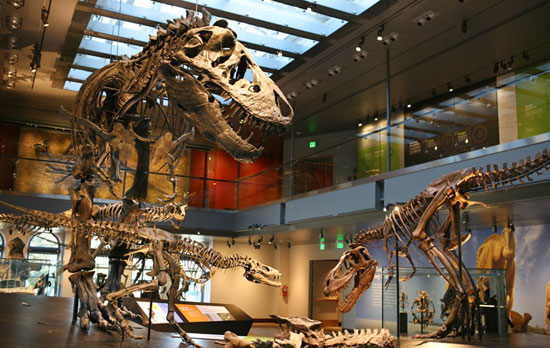Historic bash for Natural History Museum
May 30, 2013

An artist's rendering of the Natural History Museum's new entry, with a fin whale skeleton suspended above.
Los Angeles was a hard-partying hick town when top-hatted civic leaders opened its first museum, toasting it with water from the then-day-old Los Angeles Aqueduct. The fairground where the new landmark stood had been a nest of saloons and gamblers. L.A. was so culturally young that, for its first acquisition, the museum touted a goldfinch nest from the San Gabriel River bottom.
But a century can make such a difference.
On June 9, the Natural History Museum of Los Angeles County will kick off its centennial with a day and night of hoopla in the rowdy ex-fairground that is now called Exposition Park. The festivities—with kid-friendly activities, food trucks, garden tours, live music, scientists and a nighttime concert by DEVO—will not only honor one of the nation’s largest and best-known natural history museums, but also will mark a milestone in the decade-long renovation and restoration.
The museum’s hallmark 65-foot fin whale will welcome guests from the top of a dramatic new glass entrance. Two Expo Line Metro stops will ferry visitors who prefer to arrive via L.A.’s burgeoning mass transit system.
A 3.5-acre Nature Garden will blossom outside a companion, state-of-the-art Nature Lab, where visitors can study wildlife, see it in action and then collaborate with science lovers region-wide in crowdsourced “citizen science” projects. Nearby, the museum’s acclaimed new Dinosaur Hall and award-winning Age of Mammals exhibits, both already opened, will be joined in July with the unveiling of the renovation’s final piece, “Becoming Los Angeles,” a permanent installation on the development of Southern California.
Meanwhile, visitors will be able to get a local history fix in the halls and rotunda of the 1913 building, which is on the National Register of Historic Places, and which has been restored and seismically strengthened.
“If you haven’t visited the Natural History Museum in a while, you should be prepared to find a vastly different institution,” says President and Director Jane Pisano. “This is a museum that has transformed itself.”
Pisano says the remodel arose from a change of philosophy at the museum.
“The old philosophy was very typical of natural history museums everywhere,” she says. “It was all about us—how we do research, how we take care of collections—and we changed that mission to focus on the visitor.”
The new aim, she says, is not to be “a book on a wall,” but to inspire wonder and a sense of discovery and responsibility in those who come to the museum. “We were doing a good job on wonder, but not so well on discovery and least well on inspiring a sense of responsibility for the natural world.”
Nor, she says, was the museum working as well as it could with Southern California’s natural landscape.
“There are very few cities that have the kind of climate we have,” she noted. So with the help of a new, county-funded garage that has consolidated parking, acres of paved land were transformed into wildlife habitat and gardens. Meanwhile, the building’s grand architecture was tweaked to create an easier flow between indoor and outdoor wonders.
Now visitors can take in the museum’s longstanding highlights—the dinosaur bones, the marine fossils—but also enjoy workshops led by master gardeners in the edible garden and unleash their kids in a “Get Dirty Zone.” The remodel also has set the stage for a long-term “citizen science” study of local biodiversity that museum experts expect to stretch throughout the Los Angeles Basin.
“This is a place where living things will come in and we can appreciate them in the wild,” says Karen Wise, the museum’s vice president of education and exhibits. “We don’t have to just have dead things on display.”
The new Natural History Museum isn’t the only cultural institution in Southern California to be reimagining the museum experience ways that are more authentic to L.A. The Los Angeles County Museum of Art under Director Michael Govan also has taken a more indoor-outdoor approach with installations such as Michael Heizer’s “Levitated Mass” and Chris Burden’s “Urban Light” on its campus. In fact, on the same day as the Natural History Museum celebration, LACMA will unveil a proposed architectural remodel that would make the county’s 50-year-old art museum literally transparent to visitors.
“I love letting the light in,” says Pisano. “I think it changes everything about the museum. I love that it’s fun, and I love that it has become a destination where visitors of all ages can come and spend the day and still not see it all.”
And, she says, there’ll be more to love as the next century gets underway at the museum. Pisano says the renovation has upgraded about 60 percent of the public space on the campus, with plenty of projects on the horizon.
“We need to redo the auditorium,” she says. “There still are exhibit galleries that need to be re-presented. We need to redo our Gem and Mineral Hall. We’ve talked about a Hall of the Americas for a long time.
“There’s a lot to be done,” says the museum director, “but I’m so optimistic about the future of this place.”
Posted 5/29/13
















 405 bridge work causes a stink
405 bridge work causes a stink